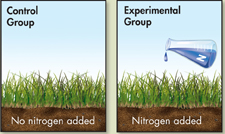Inferring and Forming a Hypothesis After posing questions, scientists use further observations to make inferences. An inference is a logical interpretation based on what scientists already know. Inference, combined with a creative imagination, can lead to a hypothesis. A hypothesis is a scientific explanation for a set of observations that can be tested in ways that support or reject it.
Designing Controlled Experiments Testing a scientific hypothesis often involves designing an experiment that keeps track of various factors that can change, or variables. Examples of variables include temperature, light, time, and availability of nutrients. Whenever possible, a hypothesis should be tested by an experiment in which only one variable is changed. All other variables should be kept unchanged, or controlled. This type of experiment is called a controlled experiment.
▸ Controlling Variables Why is it important to control variables? The reason is that if several variables are changed in the experiment, researchers can't easily tell which variable is responsible for any results they observe. The variable that is deliberately changed is called the independent variable (also called the manipulated variable). The variable that is observed and that changes in response to the independent variable is called the dependent variable (also called the responding variable).
▸ Control and Experimental Groups Typically, an experiment is divided into control and experimental groups. A control group is exposed to the same conditions as the experimental group except for one independent variable. Scientists always try to reproduce or replicate their observations. Therefore, they set up several sets of control and experimental groups, rather than just a single pair.
 In Your Notebook What is the difference between an observation and an inference? List three examples of each.
In Your Notebook What is the difference between an observation and an inference? List three examples of each.
DESIGNING CONTROLLED EXPERIMENTS

The researchers selected similar plots of marsh grass. All plots had similar plant density, soil type, input of freshwater, and height above average tide level. The plots were divided into control and experimental groups.

The researchers added nitrogen fertilizer (the independent variable) to the experimental plots. They then observed the growth of marsh grass (the dependent variable) in both experimental and control plots.
Table of Contents
- Formulas and Equations
- Applying Formulas and Equations
- Mean, Median, and Mode
- Estimation
- Using Measurements in Calculations
- Effects of Measurement Errors
- Accuracy
- Precision
- Comparing Accuracy and Precision
- Significant Figures
- Calculating With Significant Figures
- Scientific Notation
- Calculating With Scientific Notation
- Dimensional Analysis
- Applying Dimensional Analysis




